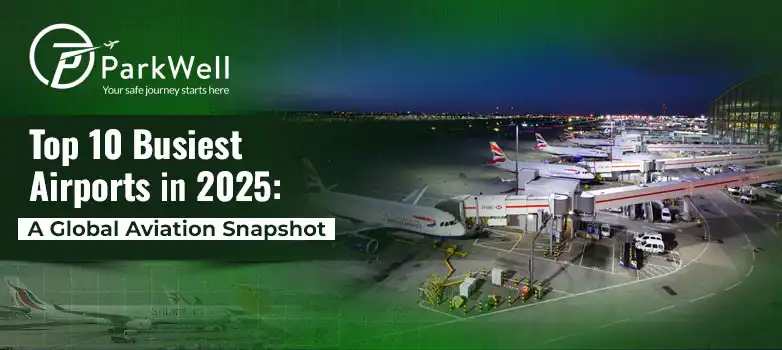
Posted On: May 02, 2025
Top 10 Busiest Airports in 2025: A Global Aviation Snapshot
Air travel in 2025 has experienced a remarkable resurgence, with airports worldwide witnessing significant increases in passenger traffic. According to the International Air Transport Association (IATA), global passenger numbers are projected to reach 5.2 billion in 2025, marking a 6.7% increase compared to 2024.
1. Dubai International Airport (DXB), UAE
Dubai International Airport continues to lead globally, with an estimated 4.78 million seats in 2025. Its strategic location as a hub connecting Europe, Asia, and Africa, coupled with Emirates' extensive network, solidifies its position at the forefront of international air travel.
2. Atlanta Hartsfield-Jackson International Airport (ATL), USA
Maintaining its status as the busiest airport in the United States, ATL is projected to handle approximately 4.57 million seats in 2025. Its extensive domestic network and status as a Delta Air Lines hub contribute to its high passenger volumes.
3. Tokyo Haneda Airport (HND), Japan
Tokyo Haneda Airport ranks third globally, with an estimated 4.22 million seats in 2025. Its proximity to central Tokyo and efficient domestic and international connections make it a preferred choice for travelers.
4. Shanghai Pudong International Airport (PVG), China
Shanghai Pudong International Airport has risen to fourth place, with around 4 million seats projected for 2025. This growth is attributed to China's expanding middle class and increased international travel demand.
5. London Heathrow Airport (LHR), UK
London Heathrow remains Europe's busiest airport, with an estimated 3.85 million seats in 2025. Its status as a major international gateway and hub for British Airways ensures high passenger traffic.
6. Dallas/Fort Worth International Airport (DFW), USA
DFW ranks sixth globally, with approximately 3.68 million seats projected for 2025. Its central location in the U.S. and status as an American Airlines hub contribute to its high passenger volumes.
7. Istanbul Airport (IST), Turkey
Istanbul Airport has climbed to seventh place, with around 3.61 million seats in 2025. Its strategic position bridging Europe and Asia, along with Turkish Airlines' expanding network, drive its growth.
8. Indira Gandhi International Airport (DEL), India
Delhi's Indira Gandhi International Airport enters the top 10, with an estimated 3.61 million seats in 2025. India's growing economy and increasing air travel demand contribute to this rise.
9. Beijing Capital International Airport (PEK), China
Beijing Capital International Airport remains a major hub, with approximately 3.57 million seats projected for 2025. Its status as China's primary international gateway ensures consistent passenger traffic.
10. Frankfurt Airport: A Major Contender in Global Aviation
In the last by seat capacity, Frankfurt Airport remains a significant player in global aviation. In 2024, it welcomed approximately 61.6 million passengers, marking a 3.7% increase from the previous year. Despite challenges such as rising regulatory costs and competition from other European hubs, Frankfurt's strategic location and extensive route network continue to support its status as a leading international airport.
In conclusion, the aviation industry in 2025 is characterized by significant growth and competition among global airports. While Dubai International Airport leads in seat capacity, airports like Frankfurt continue to play pivotal roles in international air travel. As passenger demand increases, airports must adapt to challenges and opportunities to maintain their positions in the global aviation landscape.
FAQs
Q1: What factors contribute to an airport's ranking in the busiest airports list?
A1: Airports are ranked based on total seat capacity, which includes both domestic and international flights. Factors such as strategic location, airline hubs, and passenger demand play significant roles.
Q2: How does Frankfurt Airport compare to other European airports?
A2: While Frankfurt Airport is a major hub, it faces increasing competition from airports like London Heathrow and Istanbul, which have seen significant growth in recent years.
Q3: What challenges does Frankfurt Airport face in maintaining its status?
A3: Rising regulatory costs and competition from other European airports are significant challenges. Additionally, the need for infrastructure upgrades and capacity expansion is critical to accommodate growing passenger numbers.
Q4: How has passenger traffic at Frankfurt Airport changed post-pandemic?
A4: Passenger traffic at Frankfurt Airport has shown a steady recovery post-pandemic, with 61.6 million passengers in 2024. However, it remains below pre-pandemic levels, indicating ongoing recovery efforts.
Q5: What services are available for travelers at Frankfurt Airport?
A5: Frankfurt Airport offers a range of services, including lounges, shopping, dining, and transportation options. For those seeking convenient parking solutions, park and fly Frankfurt airport services provide reliable and affordable options.
Tags
Latest Posts
-

Can You Park Overnight at BER? Here’s What to Know
-

Valet vs Shuttle: What’s the Better Choice for Airport Parking?
-

Strike at Hamburg Airport – Just in Time for the Start of the Summer Holidays
-

Summer Holidays in Germany: Start Your Vacation Stress-Free
-

New Direct Connection: Nonstop from Berlin to Toronto Now Available
Similar Posts
-

Can You Park Overnight at BER? Here’s What to Know
-

Valet vs Shuttle: What’s the Better Choice for Airport Parking?
-

Strike at Hamburg Airport – Just in Time for the Start of the Summer Holidays
-

Summer Holidays in Germany: Start Your Vacation Stress-Free
-

New Direct Connection: Nonstop from Berlin to Toronto Now Available



